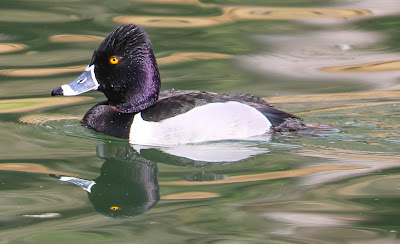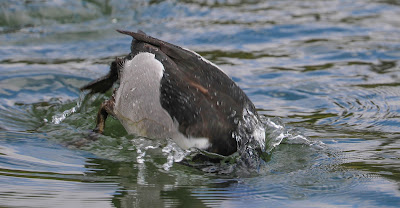I saw my
first ring-necked duck in San Angelo, Texas in March of last year. I'd never heard of it before and noted that it did not have much of a presence where we live in Southern California. I saw a few more in Texas at Aransas NWR in November of last year and then saw a few at a private reservoir in Mentone, near our home, in January of this year. I subsequently saw a few at the Los Angeles County Arboretum later in January, and then saw some at Lake Tamarisk, in the low desert near Desert Center, over the weekend. Then, to my surprise, I decided to take a look at a small pond we have in Redlands, not far from our home, at Ford Park. I have always associated that pond with tame mallards and mallard mixes, not wild ducks. I was blown away to see the pond full of ring-necked ducks and American wigeons, all wild ducks, closer up and in greater quantities than I've seen anywhere else. Merlin, the eBird on-line bird identifier, note that the ring-necked duck "favors small bodies of water, such as beaver ponds and cattail marshes," which describes our small local park pond, and that it can be "found in mixed ponds with other diving ducks" which was the case here with the American wigeons.
I share some of my ring-necked duck photos from nearby Ford Park:
 |
| The ring-necked duck has a black head that shows purplish in the right light. |
 |
| The thin reddish-purple line on the neck, just beneath the bill, is what give it the ring-necked name. However, the ring around its bill is much more prominent and it really should be called the ring-billed duck. |
 |
| The ring on the neck is much more prominent here. |
 |
| It is a diving duck and I had a ring-side seat to watch them. |
 |
| Again, the ring around the neck is quite prominent here. |
 |
| The female is quite beautiful and much more recognizable than the females of many other species of duck by the ring around the bill. |





















Those orange eyes are eerie. They look plastic.
ReplyDelete